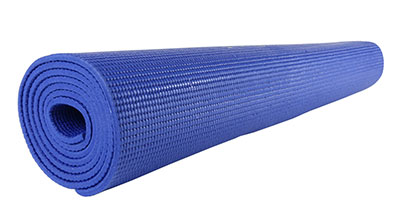Yoga has become one of the most popular workouts in the country (and worldwide), and with good reason: Yoga is great for stretching, strengthening muscles, and even meditation.
You can practice yoga on your own, but most of us prefer to go to a class with a good instructor who can make sure our moves are just right. And when attending any yoga class, the most important thing that you need to bring is your yoga mat.
Fortunately for Stay Fit guests, every Stay Fit stay comes with a CanDo® eco-friendly yoga mat to use and take home after the stay,
Each yogi has different needs or requirements for our yoga mats, but the one thing most of us will agree on is that we want an eco-friendly yoga mat.
Why Eco-friendly Yoga Mats Matter
Eco-friendly products are better for the environment, and an eco-friendly mat is equally important.
Since you are taking the time to practice yoga for the peace and workout it gives you, the last thing you want is a yoga mat that is cheaply made with plastic or a variation of it. No one wants to put their bare skin on a mat that is made of toxic material and sticks to your body.
Further, cheap mats disintegrate quickly, so investing a little more money in an eco-friendly yoga mat is certainly worth it.
Now that you know you want an eco-friendly yoga mat, there are a few other things to consider in choosing a mat:
1. Thickness
Most people prefer a 5 mm yoga (approximately 1/8 inch thick) which is ideal for most yoga types.
A somewhat firmer mat which is thicker (usually around a ¼ inch thick) could be better suited for a meditative type of yoga or if you have any joint or back pain. However, it can be tough to feel the floor at all and can make you feel a bit wobbly at times.
A thin yoga mat, on the other hand, which is generally around 1/16th inch thick, is light and easy to carry.
The thickness really depends on your specific body type and the yoga you are practicing.
2. Slippery vs. Sticky
You want traction out of your mat, especially in any of the more strenuous yoga practices, which is why a stickier mat is usually preferred.
A yoga mat that is sticky can help prevent sliding, and makes it easier to keep your alignment in check when you switch and hold poses.
3. Texture
The yoga mat’s texture will dictate the traction the mat gives you. The texture can also affect the comfort level.
A rough-textured mat is typically better than a stickier mat for the same reasons you don’t want a slippery mat. A mat that has some traction is important, but you want to be comfortable.
You can choose a mat that is a little rougher, and as you advance in yoga, you can become more experienced in how rough you want the mat.
4. Durability
Of course you want a mat that is durable and lasts a long time, but because eco-friendly mats are not made of synthetic plastic or rubber, they wear out more quickly than the cheaper brands.
However, there are many eco-friendly brands on the market — like CanDo® — that will last several years before showing any signs of wear and tear.
There are many durable, comfortable, and reasonably priced eco-friendly yoga mats that can fit your needs and budget. Take a look around and find the best yoga mat that is right for you.
Lisa Fimberg is a writer for ConsumersAdvocate.org, a website that compares different industries and products — from the best yoga mats to the best medical alert devices. When Lisa isn’t writing, you can find her out on a run or practicing yoga with her eco-friendly yoga mat!

